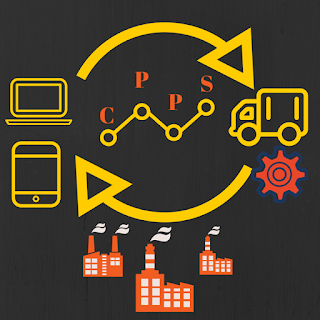 |
| CPPS - Part I |
How a possible structure of a
CPPS can look like? It will cover 3 main areas:
- Services: There will be human machine interfaces (for example smart devices such as smartphones) which have dynamically integrated apps. Those apps are capable of unbounded data exchange with the physical production machines.
- Data storage: All the data derived from the physical objects will be saved dynamically in information networks.
- Physical automation components: All your production machines and automation components will communicate through the network themselves. There will be always access and identification of the produced part and process.
Based upon those 3 areas, the
term CPPS expresses the utilization of a cyber application (for example on your
smartphone) for accessing large amounts of real-time data of a physical
production system, involving for example, an injection moulding machine. This
data can as well be analyzed by algorithms, which facilitate quick
identification of production trends combined with improved decision making. The
interaction between a physical system and the human results in a
social-technical production system.
Furthermore, the production
facilities, employees and even the companies along the value chain will be
integrated in a horizontal manner together with real time communication. Precise
mass production of individualized products will be enabled by using decentral
communication via techniques like Radio Frequency Identification Technology
(RFIT).
Another important term is ‘Industry
4.0’ which refers to the 4th industrial revolution. This can be seen
according to Prof. Hopmann (the chairman of this session) as “an evolution of
smart production ways”
What were the other industrial
revolutions? Here an overview:
- 18th century: 1st industrial revolution were mechanical plants used water and steam power for production.
- 20th century: 2nd industrial revolution results in mass production.
- Early 70’s of 20th century: 3rd industrial revolution when IT took over further automation
- Predicted for 2025: 4th industrial revolution based on cyber physical production systems.
Best practice examples of how
smart production can look like:
The company Parat GmbH which manufactures
thermoforming and CNC- machines have created a digital fabrication with a
nearly 100% vertical integration of their CNC machine production. This means that
there is no programming of the machines itself in the production. All the CNC
programs needed are written in an automatic way offline.
Another best practice example
is Festo’s Technology lead plant. It established a cooperative development
process for their polymer parts together with a fully automated flexible
manufacturing cell (paperless production, only CAD/CAM). Process simulations
based on DOE are guiding the production. Furthermore, they built up a central
production control system. This example shows how stepwisely an evolution takes
place. This is also a main differentiator compared to other industrial
revolutions.
To sum up this first part: the
long-term vision of CPPS is to establish a smart factory and smart enterprises.
In consequence, new business models will evolve and with them new chances of
adding value to the end consumer.
Exiting is to see how in the
field of injection moulding things can evolve and change. The role of the main
injection moulding machine manufacturers will be presented in the second part
of this series.
Greetings Herwig
Literature
[1] Proceedings 2nd IIMC, IKV Aachen
[2] Kunststoffe, 9/2015, p. 28

